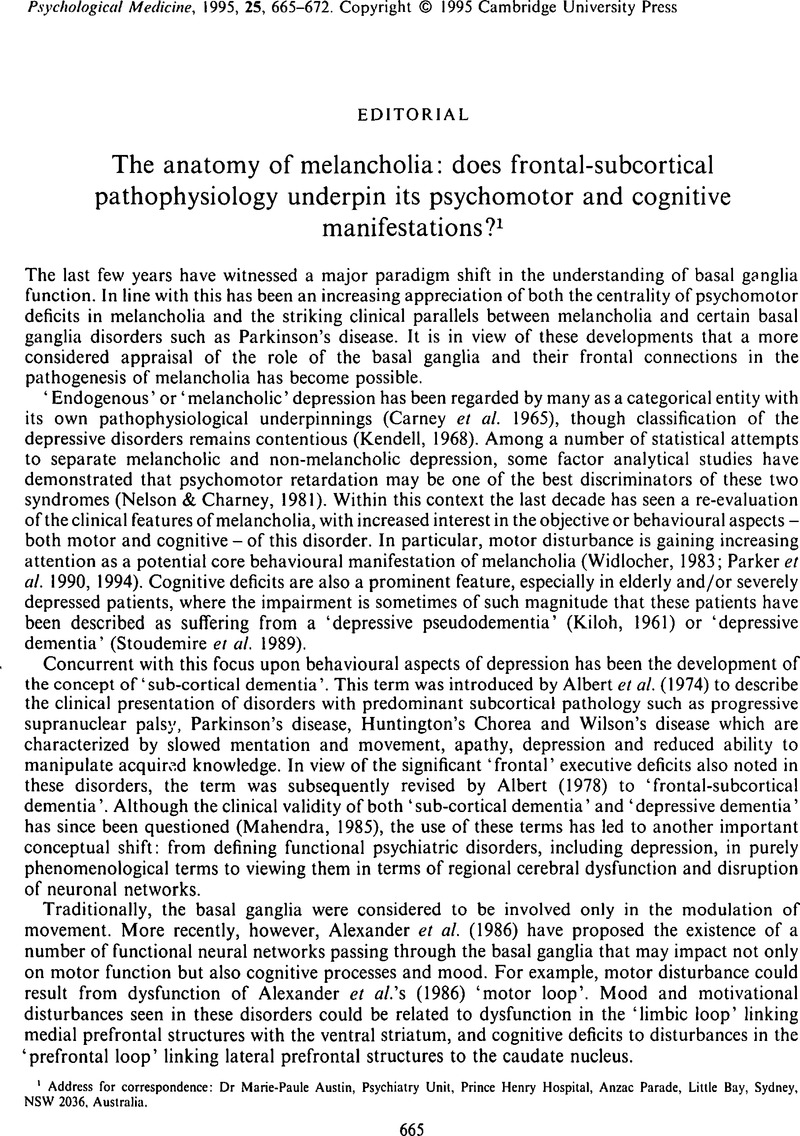Crossref Citations
This article has been cited by the following publications. This list is generated based on data provided by Crossref.
Soares, Jair C.
and
Mann, J.John
1997.
The functional neuroanatomy of mood disorders.
Journal of Psychiatric Research,
Vol. 31,
Issue. 4,
p.
393.
Hickie, Ian
Lloyd, Andrew
Dixon, Gavin
Wakefield, Denis
Halliday, Glenda
McRitchie, Deborah
Scott, Elizabeth
and
Mitchell, Philip
1997.
Utilising Molecular Biological and Histopathological Techniques to Study the Dopaminergic System in Patients with Melancholia.
Australian & New Zealand Journal of Psychiatry,
Vol. 31,
Issue. 1,
p.
27.
Videbech, P.
1997.
MRI findings in patients with affective disorder: a meta‐analysis.
Acta Psychiatrica Scandinavica,
Vol. 96,
Issue. 3,
p.
157.
Lafer, Beny
Renshaw, Perry F.
and
Sachs, Gary S.
1997.
MAJOR DEPRESSION AND THE BASAL GANGLIA.
Psychiatric Clinics of North America,
Vol. 20,
Issue. 4,
p.
885.
Kirkcaldie, Matthew T. K.
Pridmore, Saxby A.
and
Pascual-Leone, Alvaro
1997.
Transcranial Magnetic Stimulation as Therapy for Depression and Other Disorders.
Australian & New Zealand Journal of Psychiatry,
Vol. 31,
Issue. 2,
p.
264.
Soares, Jair C.
and
Mann, J. John
1997.
The anatomy of mood disorders—review of structural neuroimaging studies.
Biological Psychiatry,
Vol. 41,
Issue. 1,
p.
86.
Ulrich, G.
and
Fürstenberg, U.
1999.
Quantitative assessment of dynamic electroencephalogram (EEG) organization as a tool for subtyping depressive syndromes.
European Psychiatry,
Vol. 14,
Issue. 4,
p.
217.
Baumann, Bruno
Danos, Peter
Krell, Dieter
Diekmann, Silvia
Leschinger, Andreas
Stauch, Renate
Wurthmann, Cornelius
Bernstein, Hans-Gert
and
Bogerts, Bernhard
1999.
Reduced Volume of Limbic System–Affiliated Basal Ganglia in Mood Disorders:.
The Journal of Neuropsychiatry and Clinical Neurosciences,
Vol. 11,
Issue. 1,
p.
71.
Austin, Marie-Paule
Mitchell, Philip
Hadzi-Pavlovic, Dusan
Hickie, Ian
Parker, Gordon
Chan, Judy
and
Eyers, Kerry
2000.
Effect of apomorphine on motor and cognitive function in melancholic patients: a preliminary report.
Psychiatry Research,
Vol. 97,
Issue. 2-3,
p.
207.
Valenzuela, M.J.
Sachdev, P.S.
Wen, W.
Shnier, R.
Brodaty, H.
and
Gillies, D.
2000.
Dual Voxel Proton Magnetic Resonance Spectroscopy in the Healthy Elderly: Subcortical-Frontal Axonal N-Acetylaspartate Levels Are Correlated with Fluid Cognitive Abilities Independent of Structural Brain Changes.
NeuroImage,
Vol. 12,
Issue. 6,
p.
747.
Mindham, R.H.S.
and
Hughes, T.A.
2000.
Cognitive impairment in Parkinson's disease.
International Review of Psychiatry,
Vol. 12,
Issue. 4,
p.
281.
Sprock, June
Rader, Theresa J.
Kendall, Jeffrey P.
and
Yoder, Carol Y.
2000.
Neuropsychological functioning in patients with borderline personality disorder.
Journal of Clinical Psychology,
Vol. 56,
Issue. 12,
p.
1587.
Taiminen, Tero
Jääskeläinen, Satu
Ilonen, Tuula
Meyer, Harriet
Karlsson, Hasse
Lauerma, Hannu
Leinonen, Kirsi-Marja
Wallenius, Elina
Kaljonen, Anne
and
Salokangas, Raimo K.R.
2000.
Habituation of the blink reflex in first-episode schizophrenia, psychotic depression and non-psychotic depression.
Schizophrenia Research,
Vol. 44,
Issue. 1,
p.
69.
Austin, Marie-Paule
Mitchell, Philip
and
Goodwin, Guy M.
2001.
Cognitive deficits in depression: Possible implications for functional neuropathology.
British Journal of Psychiatry,
Vol. 178,
Issue. 3,
p.
200.
Tupler, Larry A
Krishnan, K.Ranga R
McDonald, William M
Dombeck, Carrie B
D'Souza, Sean
and
Steffens, David C
2002.
Anatomic location and laterality of MRI signal hyperintensities in late-life depression.
Journal of Psychosomatic Research,
Vol. 53,
Issue. 2,
p.
665.
Vuurman, E. F. P. M.
Honig, A.
Lamers, T. H.
Wiersma, J.
Krabbendam, L.
Hofman, P. A. M.
Nolen, W. A.
and
Jolles, J.
2002.
Event-related potentials and white matter lesions in bipolar disorder.
Acta Neuropsychiatrica,
Vol. 14,
Issue. 1,
p.
11.
Grimley Evans, John
Areosa Sastre, Almudena
and
Areosa Sastre, Almudena
2003.
Cochrane Database of Systematic Reviews.
GÜNDEL, HARALD
WOLF, ANJA
XIDARA, VASSILIKI
BUSCH, RAYMONDE
LADWIG, KARL-HEINZ
JACOBI, FRANK
VON RAD, MICHAEL
and
CEBALLOS-BAUMANN, ANDRES O.
2003.
HIGH PSYCHIATRIC COMORBIDITY IN SPASMODIC TORTICOLLIS: A CONTROLLED STUDY.
The Journal of Nervous and Mental Disease,
Vol. 191,
Issue. 7,
p.
465.
Rogers, Mark A
Kasai, Kiyoto
Koji, Matsuo
Fukuda, Rinmei
Iwanami, Akira
Nakagome, Kazuyuki
Fukuda, Masato
and
Kato, Nobumasa
2004.
Executive and prefrontal dysfunction in unipolar depression: a review of neuropsychological and imaging evidence.
Neuroscience Research,
Vol. 50,
Issue. 1,
p.
1.
Pizzagalli, D A
Oakes, T R
Fox, A S
Chung, M K
Larson, C L
Abercrombie, H C
Schaefer, S M
Benca, R M
and
Davidson, R J
2004.
Functional but not structural subgenual prefrontal cortex abnormalities in melancholia.
Molecular Psychiatry,
Vol. 9,
Issue. 4,
p.
393.



